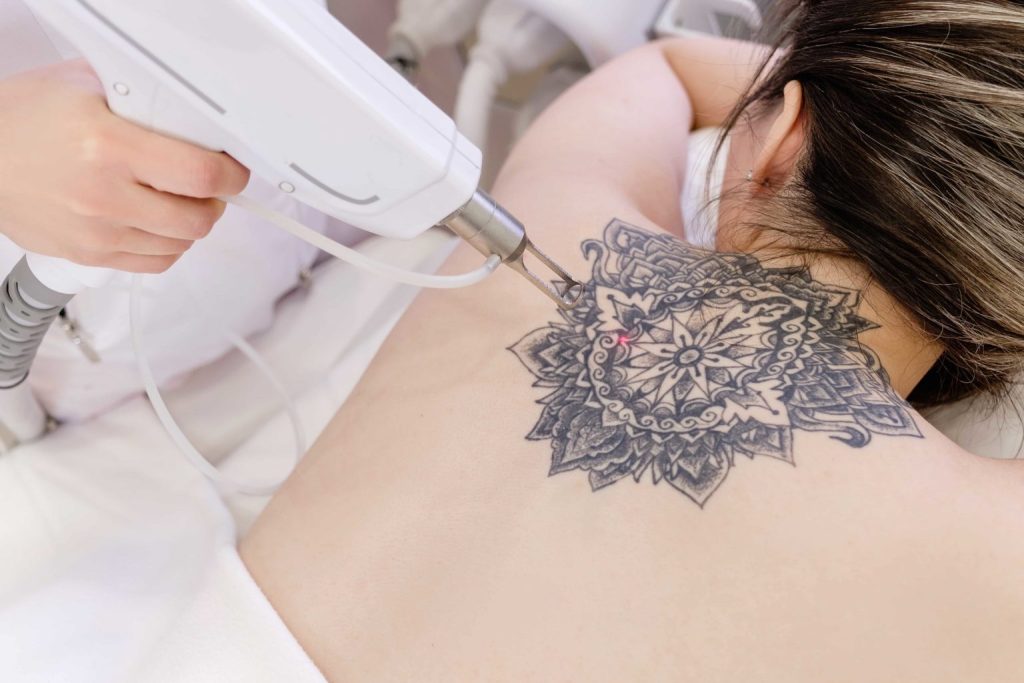Can tattoo removal be performed on all skin types?
Posted on: February 22, 2024
Tattoo removal has become a sought-after procedure for those wishing to part ways with their ink. Advances in technology have made this process more accessible and effective, offering hope to individuals looking for a fresh start. Whether driven by personal growth, career requirements, or changing tastes, the journey towards removing unwanted tattoos is no longer as daunting as it once was. This post aims to demystify the process of tattoo removal, providing readers with essential insights into what they can expect from modern techniques and how they can achieve the best possible outcomes.
Understanding Laser Tattoo Removal and Skin Tones
Skin Tone Variations
Different skin tones have unique reactions to laser tattoo removal. This is because the level of melanin, which gives skin its color, varies among individuals. Melanin can affect how a laser’s energy is absorbed by the skin.
For those with lighter skin tones, lasers target the tattoo ink without much interference from melanin. This makes the process somewhat easier. In contrast, darker skin tones have more melanin. This can lead to a higher risk of absorbing too much laser energy. It might cause changes in pigmentation or even damage if not handled correctly.
Choosing Lasers
Selecting the right type of laser for your skin tone is crucial for effective tattoo removal while minimizing risks. Not all lasers are suitable for every skin tone due to differences in absorption rates and potential effects on pigmentation.
- For lighter skin tones, Q-switched lasers are often used.
- Darker skins may require Nd:YAG lasers, which are safer for higher levels of melanin.
Consulting with a professional who understands these nuances ensures that they choose a laser compatible with your specific tone and pigment level. They will consider factors such as:
- The color of your tattoo
- Your natural skin tone
- The presence of any pre-existing conditions
This careful selection helps reduce risks like hypo or hyperpigmentation post-treatment, ensuring a smoother recovery process and better overall results in removing unwanted tattoos across different colors and tones.
The Fitzpatrick Scale and Tattoo Removal
Skin Type Identification
The Fitzpatrick Scale is crucial in tattoo removal. It classifies skin into six types. This classification is based on how skin reacts to the sun.
Knowing your Fitzpatrick type helps professionals set the laser correctly. Correct settings minimize damage during removal. They ensure a safer procedure for all involved.
Treatment Approaches
Each skin type needs a different approach. Higher Fitzpatrick types, which react more to UV light, need extra care. This prevents unwanted effects like hyperpigmentation.
Professionals adjust laser settings based on the patient’s skin type. This customization reduces pain levels and risks of damage. Staff training in these nuances ensures better outcomes for patients.
Effectiveness of Laser Tattoo Removal on Different Skin Types
Fair Skin Response
Fair skin types often experience more favorable results in tattoo removal. This is because the contrast between the ink and skin color allows lasers to target the pigment more effectively. People with lighter skin are less likely to face complications such as hyperpigmentation or hypopigmentation.
For individuals with fair skin, fewer sessions are typically needed. The laser easily distinguishes the ink from the surrounding tissue, minimizing damage to the skin.
Dark Skin Challenges
Darker skin types, including brown and black skin, may encounter challenges during tattoo removal. The presence of melanin can interfere with the laser’s ability to break down ink particles efficiently. As a result, people with darker complexions might need more treatment sessions.
Special care is required for dark-skinned individuals due to risks like hypopigmentation. Technicians use specific lasers designed to minimize these effects but achieving desired results can take longer.
Ink Factors
Not just skin type, but also ink color and depth significantly affect removal efficacy. Lighter inks tend to be harder to remove than darker ones regardless of one’s skin color.
- For light-colored tattoos: Blue and green inks are particularly challenging.
- For dark-colored tattoos: Black and red pigments absorb laser light better, making them easier to eliminate.
The effectiveness of tattoo removal varies widely among different skin types due not only to melanin content but also individual factors such as ink quality and placement depth. Therefore, each person’s results will differ based on their unique circumstances.
Duration and Process of Laser Tattoo Removal
Average Duration
Laser tattoo removal typically takes 6 to 12 sessions. Each session is spaced 6-8 weeks apart. This spacing allows the skin enough time to heal properly between treatments.
The number of sessions depends on various factors. These include the size, color, and age of the tattoo. Tattoos with multiple colors often require more sessions for complete removal.
Removal Process
The process uses lasers to break down ink particles in the skin. The body then absorbs these smaller particles naturally over time.
During each session, a laser emits short pulses of light targeted at the tattoo’s ink. This light energy causes the ink to shatter into tiny fragments without harming surrounding tissue.
After each treatment, patients may experience some redness and swelling. These side effects are temporary and usually subside within a few days.
Debunking Common Myths About Tattoo Removal
Color Matters
Not all tattoos vanish with equal ease. The color of the tattoo ink plays a crucial role in removal efficiency. Black and dark blue inks are usually easier to remove. This is because they absorb laser light better, allowing for more effective breakdown by the body’s immune system.
Lighter colors like green, yellow, and fluorescent hues can be stubborn. They require more sessions for complete removal. Each color responds differently to laser wavelengths used during the process.
Pain Levels
Laser tattoo removal isn’t always a pain-free experience. People often believe it will be as easy as getting the tattoo itself but find that’s not the case. However, discomfort associated with this procedure is manageable.
Numbing creams or local anesthesia can significantly reduce pain during sessions. These options make the process bearable for most people undergoing treatment.
Age of Tattoos
A common myth suggests newer tattoos are easier to remove than older ones; however, this isn’t typically true. Older tattoos might fade over time due to exposure and natural skin changes, making them slightly easier targets for lasers. The body’s immune system gradually breaks down ink particles after each session regardless of how new or old a tattoo is.
Impact of Laser Treatment Wavelengths on Ink and Skin Type
Color Targeting
Different wavelengths are key in targeting specific ink colors. Shorter wavelengths excel at breaking down lighter colors like red, orange, and yellow. Meanwhile, longer wavelengths penetrate deeper to tackle dark blues and blacks.
Laser settings adjust these wavelengths carefully. This precision ensures that the right pigment absorbs the laser energy effectively. The process creates shock waves that fragment the ink particles. These particles then become small enough for the body to remove naturally.
Skin Safety
Wavelength choice is critical for darker skin tones due to melanin sensitivity. Longer wavelengths pose a lower risk because they bypass melanin more easily than shorter ones do. This reduces potential damage to surrounding tissue.
For people with darker skin types, using multiple wavelengths can minimize risks during tattoo removal sessions. Technicians must select laser settings wisely to balance effective ink removal while protecting skin health.
- Pros of precise wavelength selection:
- Targets specific pigments accurately.
- Minimizes damage to surrounding tissues.
- Cons of not adjusting correctly:
- Risk of incomplete removal.
- Potential for skin damage on darker tones.
Safety, Risks, and Scarring in Tattoo Removal
Aftercare Importance
Proper aftercare is crucial. It helps prevent infections and reduces scarring risks. Following aftercare instructions closely ensures a safer healing process.
After the procedure, keep the area clean and dry. Use recommended ointments to aid healing. Avoid sun exposure to lessen scarring chances.
Technician Expertise
Choosing an experienced technician is key. They know how to minimize risks during tattoo removal. Their expertise leads to better outcomes.
An experienced professional understands different skin types and ink characteristics. This knowledge prevents complications like hyperpigmentation or hypopigmentation, especially in darker skin tones.

Skin Tone Considerations
Darker skin tones face unique challenges during tattoo removal.
- Risk of hyperpigmentation (skin darkening)
- Risk of hypopigmentation (skin lightening)
Selecting a technician with experience in treating diverse skin types is essential. They can adjust techniques accordingly, reducing unwanted side effects.
The previous section highlighted how laser treatment wavelengths affect ink and skin type interaction. Understanding this interaction further emphasizes the importance of choosing a skilled technician for optimal results while minimizing safety concerns such as scarring and other side effects.
Alternative Methods and Innovations in Tattoo Removal
Surgical Excision
Surgical excision is a method used by plastic surgeons. It removes small tattoos through surgery. This procedure offers immediate results.
Patients choose this for its quick outcome. However, it’s mainly for smaller tattoos due to scarring risks.
Picosecond Lasers
Picosecond lasers are a newer technology in tattoo removal. They work faster than traditional lasers and cause less damage to surrounding tissue.
These lasers break down tattoo ink into tiny particles. The body then removes these particles naturally. Patients see faster results with fewer sessions compared to older laser technologies.
Topical Creams
Research on topical creams for tattoo removal is ongoing. These creams aim to fade tattoos without using lasers or surgeries.
Scientists are studying how these creams can target the tattoo pigment specifically, leaving surrounding skin unharmed. While not yet widely available, they represent a promising non-invasive option for the future.
Closing Thoughts
Laser tattoo removal has evolved, offering hope to those wishing to erase past ink decisions. Understanding the process, from the Fitzpatrick Scale’s role in determining treatment efficacy to debunking myths surrounding tattoo removal, empowers individuals with knowledge. It’s crucial that they comprehend how skin type influences removal effectiveness, the duration of the process, and the potential risks involved. Alternative methods continue to emerge, broadening options for those seeking removal solutions. This comprehensive exploration underscores the importance of informed decisions and highlights the advancements in technology that make tattoo removal safer and more accessible.
For anyone considering this journey, it’s essential to consult with a professional who can provide personalized advice based on skin type and tattoo characteristics. Taking action informed by thorough research ensures a safer, more effective path to achieving desired outcomes. Let this be a call to action for further exploration and consultation with experts in the field.
Frequently Asked Questions
How does skin tone affect laser tattoo removal effectiveness?
Skin tone is categorized using the Fitzpatrick Scale, which impacts laser tattoo removal’s effectiveness. Lighter skin tones typically see better results due to less melanin absorption, reducing potential side effects and improving ink elimination.
What is the average duration for a complete laser tattoo removal process?
The complete laser tattoo removal process usually spans several sessions over 6 to 12 months. Each session’s length and total number of sessions depend on the tattoo’s size, color, depth, and individual healing rates.
Can all skin types safely undergo laser tattoo removal?
Yes, all skin types can safely undergo laser tattoo removal when appropriate wavelengths and settings are used. However, risks vary by skin type; darker tones require more specialized care to minimize adverse effects like pigmentation changes.
Are there any common myths about tattoo removal that aren’t true?
Common myths include the belief that new tattoos are easier to remove than old ones and that certain colors cannot be removed. In reality, older tattoos may fade more readily with treatment, and advancements in technology have made it possible to target a wider range of ink colors effectively.
How do different wavelengths impact the success of removing colored tattoos?
Different wavelengths target specific ink colors more effectively during laser treatment. For example, 1064 nm wavelengths are ideal for dark blues and blacks, while 532 nm settings are better suited for reds and oranges. Choosing the correct wavelength is crucial for successful color-specific ink breakdown.
What safety measures should one consider before undergoing a laser tattoo removal procedure?
Before undergoing a procedure, ensure you consult with a qualified professional who can assess your specific needs based on your skin type and health history. Discuss potential risks like scarring or changes in pigmentation especially if you have darker skin or sensitive areas treated.





